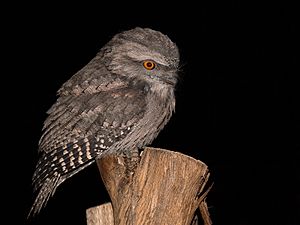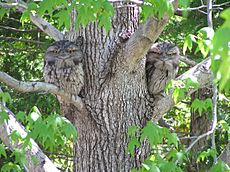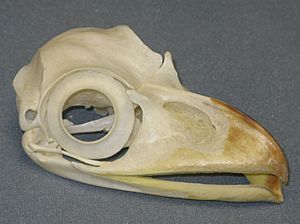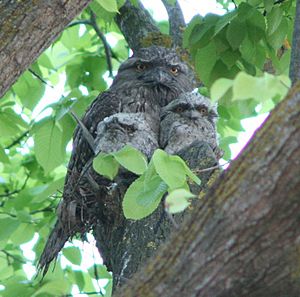Tawny frogmouth facts for kids
Quick facts for kids Tawny frogmouth |
|
|---|---|
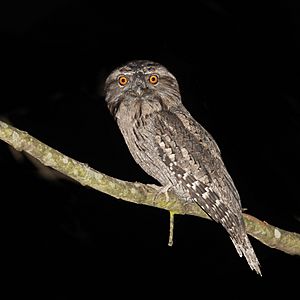 |
|
| Conservation status | |
| Scientific classification | |
| Genus: |
Podargus
|
| Species: |
strigoides
|
The tawny frogmouth (Podargus strigoides) is a special bird found all over Australia and Tasmania. It has a big head and a strong body. People often mistake it for an owl because it hunts at night and has similar colors. Sometimes, it's even called mopoke, but that name is also used for another bird, the Australian boobook. In a 2019 poll, Australian readers voted the tawny frogmouth the second most popular bird!
Contents
What's in a Name?
The name for this bird in an old Aboriginal language, Proto-Pama–Nyungan, was *tawa or *tawu.
Bird Family and Types
The tawny frogmouth was first described in 1801 by an English expert named John Latham. Its scientific name, strigoides, comes from Latin words meaning "owl" and "form". This shows how much it looks like an owl!
Tawny frogmouths belong to a group of birds called Podargus. There are two other types of frogmouths in Australia: the marbled frogmouth and the Papuan frogmouth. Even though they look a bit like owls, their closest relatives are birds like oilbirds, potoos, and nightjars. Scientists believe frogmouths have been around since the Eocene period, which was millions of years ago!
There are three main types, or subspecies, of the tawny frogmouth:
- P. s. phalaenoides: Lives in Northern Australia, going south to the Great Sandy Desert and Queensland.
- P. s. brachypterus: Found in Western Australia, reaching north to the Great Sandy Desert and southeast to Victoria.
- P. s. strigoides: Lives in Eastern and South Eastern Australia, from north of Cooktown to the Great Dividing Range, and in Tasmania.
How to Spot a Tawny Frogmouth
Tawny frogmouths are big birds with large heads. They can be about 34 to 53 cm (13 to 21 in) long. They usually weigh between 157 to 555 grams (5.5 to 19.6 oz). They have strong, compact bodies with rounded wings and short legs. Their beaks are wide, heavy, and hooked at the end, with cool tufts of bristles on top. Like owls, they have big yellow eyes, but their eyes face more to the side, not straight forward.
Tawny frogmouths come in three different colors, called morphs. Grey is the most common color for both males and females.
- Grey males have silver-grey feathers on top with black stripes. Their undersides are lighter with white bars and brown spots.
- Grey females are often darker with more reddish-brown spots.
- Some females, especially in certain areas, can be chestnut or reddish-brown all over.
Very rarely, some tawny frogmouths can be all white, which is called leucistic or albinistic.
Amazing Camouflage Skills
One of the most amazing things about the tawny frogmouth is how well it can hide. During the day, they sit very still on tree branches, looking exactly like part of the tree. Their grey, white, black, and brown feathers help them blend in perfectly with tree bark. They often pick a broken branch and point their heads straight up, using their big beaks to look even more like a broken branch.
Often, a pair of frogmouths will sit together, pointing their heads up. They only move if someone gets too close. If they feel threatened, adult frogmouths make a special alarm call. This tells their chicks to stay quiet and still, so their natural camouflage isn't broken.
How They Differ from Owls
Tawny frogmouths and owls both have spotted feathers, wide eyes, and similar feet. However, there are some key differences:
- Owls have strong legs and powerful talons to catch prey. Tawny frogmouths use their beaks to catch food and have weaker feet.
- Frogmouths rest out in the open, relying on their camouflage. Owls hide in thick leaves.
- Frogmouths build their nests in tree forks. Owls build nests in tree hollows.
- Tawny frogmouths have wide, forward-facing beaks for catching insects. Owls have narrow, downward-facing beaks for tearing prey.
- Frogmouths' eyes are more to the side of their face, while owls' eyes face completely forward.
- Owls have special face discs and large, uneven ears to help them hear. Tawny frogmouths do not have these.
Where They Live and Their Homes
Tawny frogmouths live across most of mainland Australia. They are also common in northern and eastern Tasmania.
You can find them in many different places, like forests, woodlands, scrub areas, and savannahs. They usually avoid very dense rainforests or deserts with no trees. They love areas with lots of river gums and casuarina trees, especially along rivers. These birds have even learned to live near people and are often seen nesting in parks and gardens in suburbs.
Life and Habits of the Tawny Frogmouth
What They Eat and How They Hunt
Tawny frogmouths are meat-eaters. They are very helpful birds because they eat many creatures that people consider pests in homes and gardens. Most of their diet is made up of large insects that come out at night, like moths. They also eat spiders, worms, slugs, and snails. Sometimes, they catch small mammals, reptiles, frogs, and even other birds.
During the day, they usually don't look for food. But sometimes, they sit with their mouths open, ready to snap shut if an insect flies in. As evening comes, they start actively hunting. They often pounce from a tree branch to catch insects or small animals on the ground with their beaks. They can even catch smaller prey, like moths, while flying.
When they catch something, they hold it in their beak and take it to a nearby branch. Insects are usually crushed before being swallowed. Larger prey, like lizards or mice, are often killed by hitting them against a branch before they are eaten.
Bonding and Reproduction
Tawny frogmouths usually stay with the same partner for their whole lives. Once they find a partner, they often stay in the same area for ten years or more. Staying close and touching is very important for their bond. During the breeding season, pairs sit very close together on the same branch, often touching. The male bird will gently groom the female's feathers with his beak, sometimes for more than 10 minutes.
The breeding season is from August to December. However, in dry areas, they might breed after heavy rains. Both male and female birds help build the nest. They collect twigs and leaves, dropping them into place. Nests are usually built on horizontal, forked tree branches and can be up to 30 cm (12 in) wide. They pile loose sticks and add leaves and grass to make the center soft. These nests can be quite fragile.
A female tawny frogmouth lays one to three eggs. Both parents take turns sitting on the eggs to keep them warm. The male usually sits on the eggs during the day. They rarely leave the nest alone. One parent will sit on a nearby branch and bring food to the one on the nest. Once the chicks hatch, both parents work together to feed them. The young birds leave the nest after 25 to 35 days, by which time they are about half the size of an adult.
Bird Calls and Sounds
Tawny frogmouths make many different sounds to share information about their sex, their territory, food, or dangers. They usually use quiet, low-pitched sounds to talk to each other, but some of their warning screams can be heard from far away. Baby birds make special calls when they are upset, hungry, or scared. Young birds keep these calls and also develop a loud begging call for food. All frogmouths, from babies to adults, use a quiet "annoyance" call for family members. If they are disturbed while resting, they might make a soft buzzing sound, like a bee. If they feel very threatened, they can hiss loudly and click their beaks.
At night, tawny frogmouths make a deep, continuous "oom-oom-oom" sound, about eight calls every five seconds. These steady grunts are often repeated throughout the night. They also make a soft, quiet "whoo-whoo-whoo" call at night. Before and during the breeding season, males and females often sing together, either taking turns or singing at the same time. They also make drumming noises during breeding season.
Staying Warm or Cool
Tawny frogmouths live in many parts of Australia, where winter nights can be freezing (below 0 °C or 32 °F) and summer days can be extremely hot (above 40 °C or 104 °F). Since they rest out in the open all day, they need special ways to control their body temperature.
In summer, when the sun is strongest, they choose branches that are not in direct sunlight all day. They can breathe three times faster without opening their beaks to cool down. But if their body temperature goes up too much (4-5°C), they start to pant. If it gets even hotter, they send more blood to the blood vessels in their mouth. They also produce a sticky liquid (mucus) that helps cool the air as they breathe it in, which cools their body.
In winter, tawny frogmouths choose branches that face north, so they get more sunlight to warm up. Pairs often huddle together to share body warmth. During the day, they sometimes sit on the ground to sunbathe for up to 5 minutes. When they do this, they open their beaks wide, close their eyes, and tilt their heads to let the sun's rays get under their thick feathers.
Saving Energy with Torpor
During winter, food can be hard to find. The fat they stored before winter only lasts so long. To survive, tawny frogmouths spend much of their days and nights in a state called torpor. Torpor helps them save energy by greatly slowing down their heart rate and metabolism, which lowers their body temperature.
Torpor is different from hibernation because it only lasts for short periods, usually a few hours. Light torpor happens daily in winter, lasting several hours and only lowering their temperature a little (0.5 to 1.5 °C). Deeper torpor at night can last several hours and lower their body temperature by up to 10 °C.
Protecting Tawny Frogmouths
The tawny frogmouth is considered a "least concern" species because it is found in so many places. However, there are still some dangers to their populations. Many animals, like birds and mammals, hunt tawny frogmouths. Native birds like ravens, butcherbirds, and currawongs might try to steal their protein-rich eggs to feed their own young. Birds of prey like hobbies and falcons, as well as rodents and tree-climbing snakes, also cause problems by taking eggs and chicks. In warmer areas where food is available all year, frogmouths sometimes start breeding earlier in winter to avoid snakes waking up after hibernation.
Since 1998, some tawny frogmouths in Sydney have gotten a brain disease caused by a parasite called Angiostrongylus cantonensis, which is a rat lungworm.
How Humans Affect Them
Tawny frogmouths face several dangers from human activities and pets. They are often hit by cars on rural roads while hunting. This happens because they fly in front of car headlights to catch insects. Large-scale land clearing of eucalypt trees and big bushfires are serious threats because these birds often don't move to new areas if their homes are destroyed.
House cats are the biggest danger from introduced animals. Dogs and foxes also sometimes kill these birds. When tawny frogmouths pounce to catch prey on the ground, they are slow to fly away, making them easy targets for predators.
Because they live close to people, tawny frogmouths are at high risk from pesticides. The continued use of insecticides and rodent poisons is dangerous. These poisons stay in the bodies of the animals they eat and can be deadly to a tawny frogmouth. The effects can be tricky because the poison can be stored in their fat. The bird might not seem sick until winter, when it uses its fat stores, and the poison enters its bloodstream.
- Kaplan, Gisela: Tawny Frogmouth, CSIRO Publishing, Collingwood, 2007, ISBN: 978-0-643-09239-6
See also
 In Spanish: Podargo australiano para niños
In Spanish: Podargo australiano para niños



